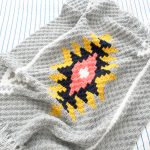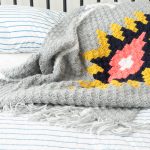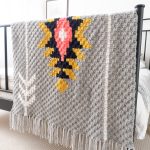Southwest -Inspired Sunburst Afghan by ChiWei (One Dog Woof)
Corner to corner crochet, also known as C2C crochet, is a technique that works stitches back and forth, but at a diagonal, from one far corner to the other. Looking at a corner to corner project can be perplexing, as you often see stitches that seem backwards and upside down, but the concept is surprisingly simple and the technique surprisingly versatile. I love corner to corner crochet, and it’s one of my fallback staples when I’m looking for a light, warm crochet fabric. Here’s 5 characteristics about corner to corner crochet that can help take the mystery out of it for you, so it can become one of your staple techniques too!
1. Did you know, you can create an entire corner to corner project with just 3 basic stitches? You’ll only need to know a chain stitch, a slip stitch, and the double crochet stitch. These 3 stitches make up the basic corner to corner square unit, and you’re on your way! There’s no counting stitches (unless you’re changing colors according to a pattern), so it’s a perfect stitch to play with while watching a movie.
2. The corner to corner square unit is made up of a grouping of 3 double crochet stitches worked into the same chain space. However, you can alter the size of that square unit by using half-double crochet stitches instead of double crochet stitches. My double crochet square units average around 0.75” square using Lion Brand Vanna’s Choice, so a 48 square wide afghan ends up around 36” wide. Using a half-double crochet stitch would make my square units smaller, so I can fit more in the same 36” wide afghan, allowing a more complex graph pattern.
3. Corner to corner crochet uses what I call square units, but you don’t have to make your final project a square! If you increase and decrease your rows at the same time, you create a square project, but decreasing at different rows means you can create a rectangle instead. You can even experiment with increasing and decreasing rows, and make a free-flowing organic shape!
4. One of my favorite characteristics about corner to corner crochet is that your final product is reversible! Even with tapestry crochet, there’s always a sense of the front side vs the back side, but both sides of a corner to corner afghan looks exactly the same. You can carry different colors of yarn through your work and weave in ends both easily and invisibly.
5. Here’s the kicker – with corner to corner crochet, your design options are endless. Anything you can draw on graph paper, you can crochet. Letters, shapes, animals, it’s all possible! Complex shapes need larger graphs to smooth out the curves, which make for larger afghans or blankets, but you can make modern and beautiful designs with simple graphs and bold colors as well. The Southwest-inspired Sunburst afghan, which is 49 units wide and features triangle and arrow motifs, is an example of a larger, bold graphic design.
Hopefully, now you know enough about corner to corner crochet to want to make your own project! You can purchase the Sunburst Afghan kit and get everything you need to get started. Then head over to my blog at One Dog Woof to see a collection of corner to corner crochet tutorials for beginners, and my series of corner to corner crochet videos, that take you step by step through the different scenarios you’ll encounter in your project, from starting your first square unit all the way to weaving in your ends. I hope you enjoy the ride!
— ChiWei (One Dog Woof)



Serene
I’ve made the owl c2c with yarn from my stash. Now am making a shawl, using #3 yarn and a J hook. Just keep increasing and use a pretty yarn and a larger than normal hook to get a more open effect. No pattern needed. The trick for me was realizing that you’re crocheting into the side of the shell, not the top.